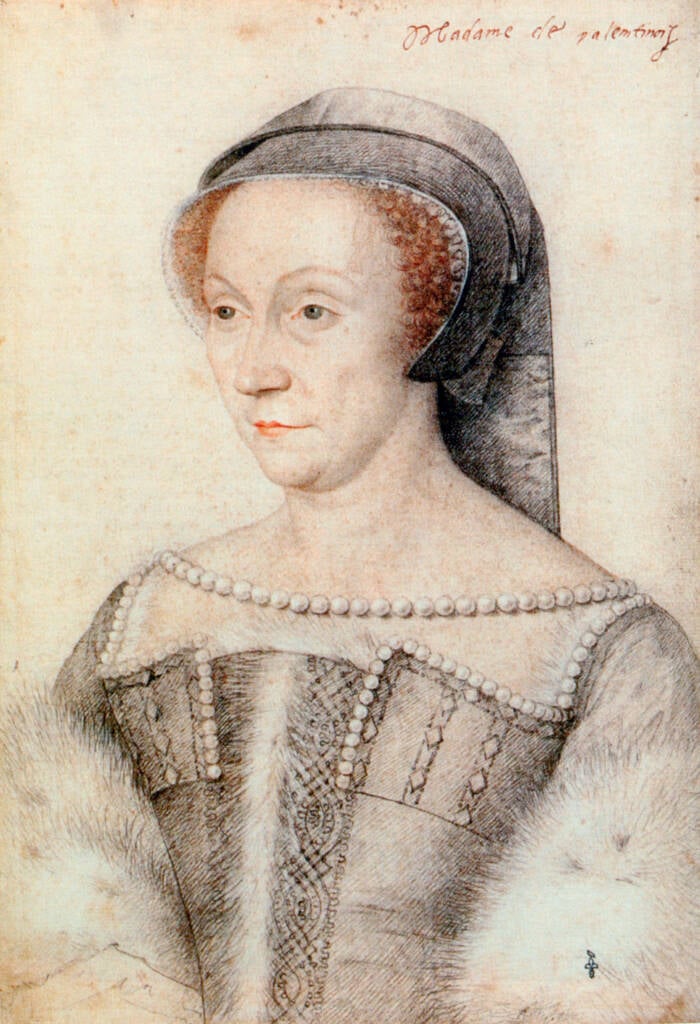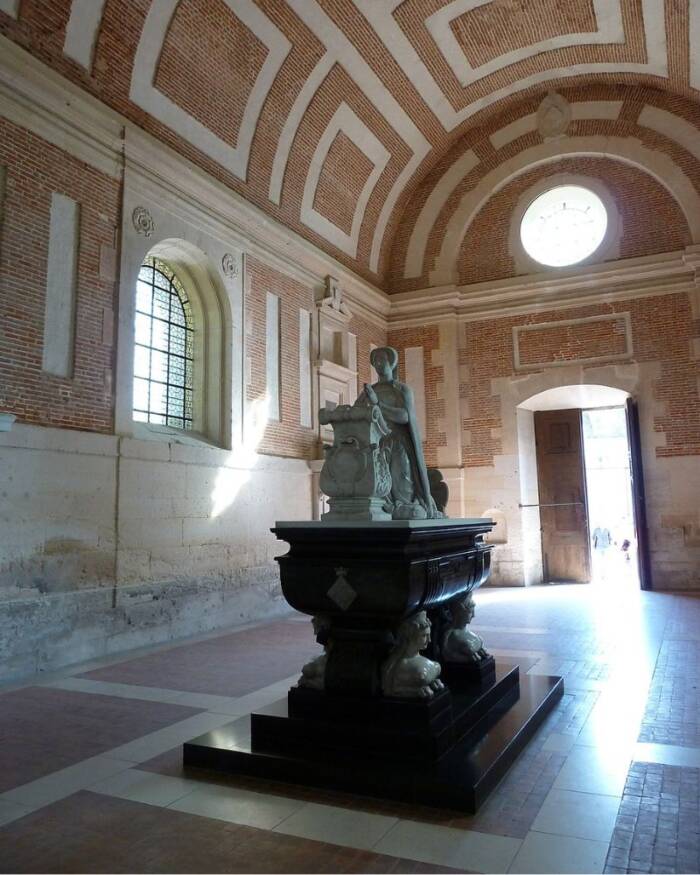King Henry II openly preferred Diane de Poitiers over his legitimate wife — and he treated his lover as an unofficial queen.

Public DomainA portrait of Diane de Poitiers, c. 1565.
History is rife with tales of royal mistresses, from Anne Boleyn to Madame de Pompadour. In 16th-century France, one such woman so bewitched the reigning king that she held more influence than his actual queen. Her name was Diane de Poitiers.
Diane was the mistress of Henry II, and they began their decades-long affair when she was 35 and he was just 15. For the next 25 years, Diane would stay by Henry’s side as he rose from Duke of Orléans to King of France.
Once Henry was in charge, Diane de Poitiers was untouchable. The king gave her the Crown Jewels of France and a château that his own wife, Catherine de’ Medici, was desperate to have for herself. Diane helped raise Henry’s children, advised him on political matters, and even answered correspondence for him, signing the letters with a mash-up of their names: “HenriDiane.”
But when Henry died in a jousting accident in 1559, the queen was finally able to show her true feelings for Diane. Catherine banished Diane from the royal court. Once the most powerful woman in France, Diane de Poitiers lived out her last years in exile.
The Beginning Of Henry And Diane’s Relationship
Diane de Poitiers was born in Drôme, France, around 1499. Her father was a nobleman, and she was educated in subjects like Latin, Greek, and rhetoric like other wealthy children of the time.
When she was 15, Diane married Louis de Brézé, who was 39 years her senior. Ironically, he was the grandson of King Charles VII of France and his mistress, Agnès Sorel. Louis served as a courtier to King Francis I, Henry’s father, and through him Diane became a lady-in-waiting to multiple powerful women, including Francis’ wife, Queen Claude.

Public DomainHenry II of France in 1559.
Diane may have already been working for the queen when Henry was born in 1519. She was certainly at court in 1526, when Henry and his older brother, Francis, were sent to Spain as hostages. They were imprisoned in place of their father the king, who had been captured in battle by Holy Roman Emperor Charles V’s troops the previous year.
Legend has it that Diane de Poitiers kissed seven-year-old Henry’s cheek to comfort him as he was handed to his Spanish captors, and that kindness stayed with him throughout his four-year confinement. In fact, shortly after the brothers returned to France in 1530, a tournament was held to celebrate their father’s marriage to Eleanor of Austria. The boys dressed as knights, and young Francis wore Eleanor’s colors — but Henry wore the colors of Diane.
Diane’s husband died in 1531, and in 1533, Henry married Catherine de’ Medici at the age of 14. Historians generally believe that their affair began just a year after Henry and Catherine’s marriage, when Henry was 15 and Diane was 35.
At the time, Henry was never supposed to be the king of France. His older brother Francis was poised to take the throne. Then, in 1536, the dauphin collapsed after playing tennis and died shortly thereafter. Henry became the heir apparent — and Diane de Poitiers became the mistress of the next king of France.
How Diane De Poitiers Became The Most Powerful Woman In France
Diane’s rise to power wasn’t simple. King Francis I had an affair partner of his own named Anne de Pisseleu, and she didn’t like Diane. In 1544, Anne convinced the king that Henry and Diane were trying to reinstate a courtier who had previously been exiled. King Francis banished Diane from court — and Henry left with her.
Francis died just three years later, however, and Diane de Poitiers soon became one of the most influential women in France. To the humiliation of Catherine, as Nancy Goldstone reported in her book The Rival Queens: Catherine de’ Medici, Her Daughter Marguerite de Valois, and the Betrayal that Ignited a Kingdom, the affair was so well-known by then that when Pope Paul III sent the new queen a traditional “Golden Rose” ornament upon Henry’s coronation, he also sent Diane a gift: a pearl necklace.

Public DomainA painting by Giorgio Vasari of the marriage of Henry II and Catherine de’ Medici in 1933.
Henry gave Diane almost anything she wanted, and she often advised him on various matters and wrote correspondence for him, signing their joint name “HenriDiane” at the bottom of the letters. The new king also bestowed various titles on Diane, such as Duchess of Valentinois and Duchesse d’Étampes.
Still, Diane knew that she had to keep Catherine happy as well. She often encouraged Henry to go to his wife’s bed, and the royal couple welcomed 10 children together over the course of Henry’s reign.
Henry had other affair partners, too, however. He had at least three illegitimate children with other women — including a little girl named Diane with Filippa Duci. But Diane de Poitiers was Henry’s favorite, and she was often charged with taking care of the king’s children, both legitimate and illegitimate. In fact, she essentially raised young Diane as her own.

Public DomainCatherine de’ Medici, c. 1560.
Catherine de’ Medici was able to look past the affair for the most part. But when Henry gave Diane the Crown Jewels of France and gifted her Cháteau de Checonceau, a beautiful castle that Catherine coveted, the queen was furious. What’s more, Henry often wore Diane’s ribbons, or “favors,” rather than his wife’s during jousting tournaments, which humiliated Catherine.
Indeed, Henry was sporting Diane’s ribbon on June 30, 1559, when he was fatally wounded in the eye while jousting. Catherine refused to let Diane into Henry’s bedchamber, even though the king reportedly cried out for her frequently. Henry died from sepsis on July 10, 1559 — and Diane de Poitiers’ influence immediately came to an end.
Diane De Poitiers’ Final Years In Exile
At last able to display her true feelings about Diane, Catherine’s first order of business was forcing Diane to return the Crown Jewels. Then, she made the royal mistress give her Chenonceau in exchange for the much less appealing Château de Chaumont. Once Catherine had her jewels and property in hand, she banished Diane from court.
Essentially in exile, Diane de Poitiers retired to Château d’Anet, the manor she’d built on the property of her late husband. Already 60 at the time of Henry’s death, Diane lived out her final years at Anet quietly.
Then, around 1565, Diane fell from her horse and sustained injuries from which she never fully recovered. She died on April 25, 1566 at the age of 66. According to the medical humanities journal Hektoen International, a study of her corpse in 2008 determined that she had fractured her tibia and fibula during the fall.

Wikimedia CommonsDiane de Poitiers’ tomb near Château d’Anet.
The examination also found extremely high levels of gold in Diane’s hair, apparently confirming the rumors that she had consumed gold elixir during her lifetime in an effort to maintain her youthful appearance. It’s unknown whether this habit may have also contributed to her death.
Diane de Poitiers was originally buried in an elaborate tomb near Anet. During the French Revolution 200 years later, however, the tomb was opened, her corpse was desecrated, and her remains were tossed into a mass grave, where they were rediscovered in 2008. After the study of Diane’s remains, she was reinterred in her original tomb.
Diane de Poitiers lived a life many could only dream of. From her wealthy beginnings to her time as France’s most influential woman, the royal mistress made an indelible mark on those who knew her — and on French history.
After reading about the life of Diane de Poitiers, learn how England’s King Henry VI had to use “sex coaches” to procreate. Then, go inside the life of Catherine Parr, the last wife of King Henry VIII.





